镍铁生产工艺课件
- 格式:ppt
- 大小:506.50 KB
- 文档页数:76
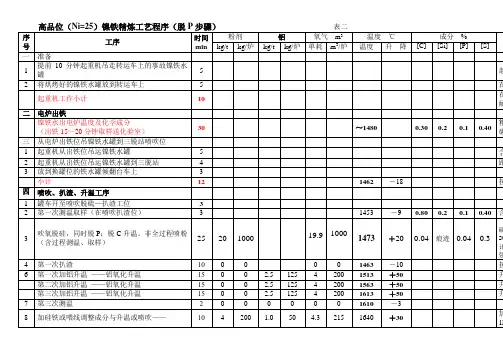
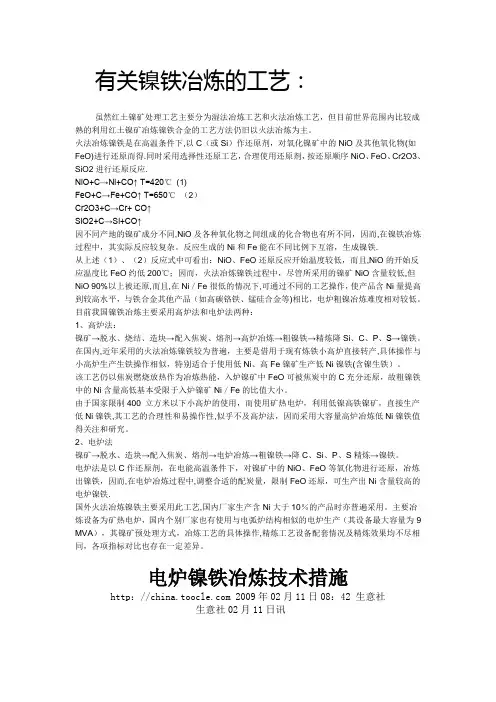
有关镍铁冶炼的工艺:虽然红土镍矿处理工艺主要分为湿法冶炼工艺和火法冶炼工艺,但目前世界范围内比较成熟的利用红土镍矿冶炼镍铁合金的工艺方法仍旧以火法冶炼为主。
火法冶炼镍铁是在高温条件下,以C(或Si)作还原剂,对氧化镍矿中的NiO及其他氧化物(如FeO)进行还原而得.同时采用选择性还原工艺,合理使用还原剂,按还原顺序NiO、FeO、Cr2O3、SiO2进行还原反应.NiO+C→Ni+CO↑ T=420℃(1)FeO+C→Fe+CO↑ T=650℃(2)Cr2O3+C→Cr+ CO↑SiO2+C→Si+CO↑因不同产地的镍矿成分不同,NiO及各种氧化物之间组成的化合物也有所不同,因而,在镍铁冶炼过程中,其实际反应较复杂。
反应生成的Ni和Fe能在不同比例下互溶,生成镍铁.从上述(1)、(2)反应式中可看出:NiO、FeO还原反应开始温度较低,而且,NiO的开始反应温度比FeO约低200℃;因而,火法冶炼镍铁过程中,尽管所采用的镍矿NiO含量较低,但NiO 90%以上被还原,而且,在Ni/Fe很低的情况下,可通过不同的工艺操作,使产品含Ni量提高到较高水平,与铁合金其他产品(如高碳铬铁、锰硅合金等)相比,电炉粗镍冶炼难度相对较低。
目前我国镍铁冶炼主要采用高炉法和电炉法两种:1、高炉法:镍矿→脱水、烧结、造块→配入焦炭、熔剂→高炉冶炼→粗镍铁→精炼降Si、C、P、S→镍铁。
在国内,近年采用的火法冶炼镍铁较为普遍,主要是借用于现有炼铁小高炉直接转产,具体操作与小高炉生产生铁操作相似,特别适合于使用低Ni、高Fe镍矿生产低Ni镍铁(含镍生铁)。
该工艺仍以焦炭燃烧放热作为冶炼热能,入炉镍矿中FeO可被焦炭中的C充分还原,故粗镍铁中的Ni含量高低基本受限于入炉镍矿Ni/Fe的比值大小。
由于国家限制400 立方米以下小高炉的使用,而使用矿热电炉,利用低镍高铁镍矿,直接生产低Ni镍铁,其工艺的合理性和易操作性,似乎不及高炉法,因而采用大容量高炉冶炼低Ni镍铁值得关注和研究。
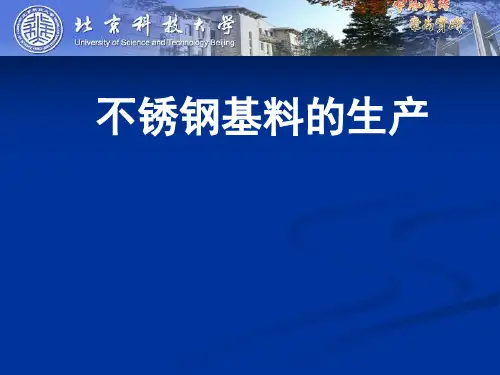
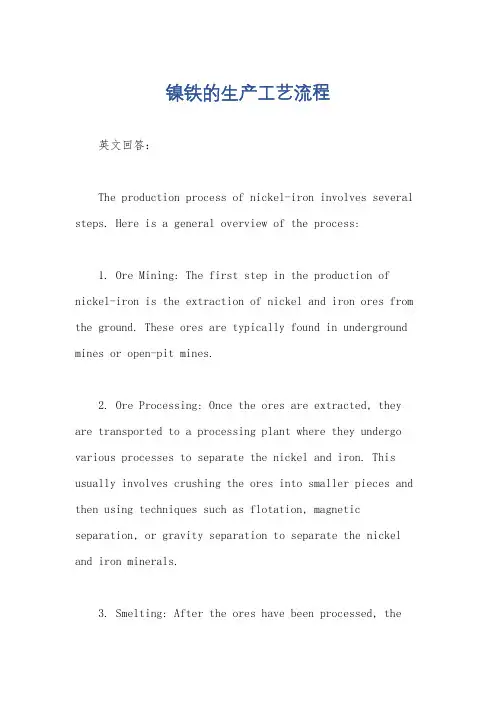
镍铁的生产工艺流程英文回答:The production process of nickel-iron involves several steps. Here is a general overview of the process:1. Ore Mining: The first step in the production of nickel-iron is the extraction of nickel and iron ores from the ground. These ores are typically found in underground mines or open-pit mines.2. Ore Processing: Once the ores are extracted, they are transported to a processing plant where they undergo various processes to separate the nickel and iron. This usually involves crushing the ores into smaller pieces and then using techniques such as flotation, magnetic separation, or gravity separation to separate the nickel and iron minerals.3. Smelting: After the ores have been processed, thenext step is smelting. Smelting is the process of heating the ores at high temperatures in a furnace to extract the metal from the ores. In the case of nickel-iron, the ores are heated along with a reducing agent, such as coke or coal, which reacts with the oxygen in the ores to produce metallic nickel and iron.4. Refining: Once the nickel and iron have been extracted, they undergo further refining processes to remove impurities and improve the quality of the metal. This may involve processes such as electrorefining, where an electric current is passed through the metal to remove impurities, or vacuum distillation, where the metal is heated under vacuum to remove volatile impurities.5. Alloying: Nickel-iron is often used as an alloying element in the production of stainless steel and other alloys. In this step, the nickel-iron is combined with other metals, such as chromium or molybdenum, to create the desired alloy composition. This may involve melting the nickel-iron and other metals together in a furnace and then casting or forging the alloy into the desired shape.6. Final Processing: Once the alloy has been formed, it may undergo additional processes such as heat treatment, machining, or surface treatment to further improve its properties and prepare it for its intended use.中文回答:镍铁的生产工艺流程包括以下几个步骤:1. 矿石开采,镍铁的生产首先需要从地下或露天矿场中提取镍和铁矿石。

RKEF冶炼工艺概述-图文前言目前,国内外红土镍矿的处理方法主要有火法和湿法两种冶炼工艺,湿法工艺是使用硫酸、盐酸或者氨水溶液作为浸出剂,浸出红土镍矿中的镍和钴金属离子,常见的湿法处理工艺有高压酸浸工艺(HPAL)、常压酸浸工艺(PAL)和氨浸工艺(Caron)。
火法工艺是在高温条件下,以C作还原剂,对氧化镍矿中的NiO及其他氧化物进行还原而得。
火法冶炼因具有流程短、三废排放量少、工艺成熟等特点,已成为红土镍矿冶炼的主要工艺。
目前国内外主要有4种火法工艺:烧结—高炉流程(BF法);回转窑—电炉熔炼流程(RKEF法);多米尼加鹰桥竖炉—电炉工艺;日本大江山回转窑直接还原法。
其中,RKEF法是当今世界上火法处理红土镍矿的先进及成熟工艺,广泛地应用于各国冶炼厂家。
RKEF(RotaryKiln-ElectricFurnace)法始于上世纪50年代,由Elkem公司在新喀里多尼亚的多尼安博厂开发成功,具有产品质量好、生产效率高、节能环保等优点。
在不锈钢产量大幅增幅的驱动下,RKEF法镍铁的生产能力急剧增加。
我国冶炼镍铁电炉炉容在不断地扩大。
额定容量25MVA的炉型已经逐步退出主体炉型,进而33MVA、36MVA、48MVA、51MVA成为主体炉型。
与此同时,我国矿热炉生产镍铁的工艺流程更加合理,矿热电炉的总体装备水平大幅度提高,冶炼工艺技术更加成熟。
下面将概括介绍和讨论矿热电炉利用红土镍矿采用RKEF法冶炼镍铁的工艺技术。
1工艺流程概述利用红土镍矿生产镍铁的RKEF冶炼工艺流程如图1.1:图1.1RKEF工艺流程图工艺流程主要包含以下几个阶段:(1)在露天料场进行红土矿的晾晒;大块红土矿的破碎、筛分、混匀。
(2)应用干燥窑对红土矿进行干燥;应用回转窑进行红土矿的焙烧预还原。
以此获得焙砂。
(3)矿热电炉熔炼焙砂生产含镍生铁。
(4)回转窑与电炉余热的利用。
(5)粉尘的收集与再利用。
对RKEF法工艺的流程,矿石内部的成分尤为重要,其中有至少3个指标,在生产时需要关注:(1)Ni品位,控制在1.5以上,最好2.0以上。
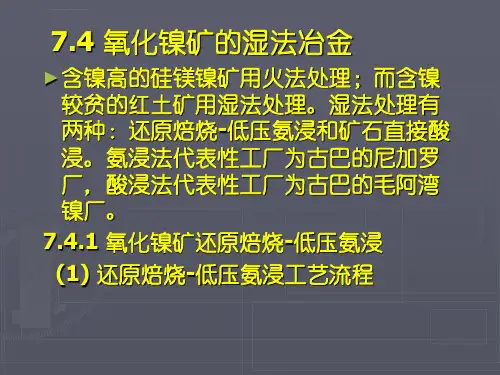

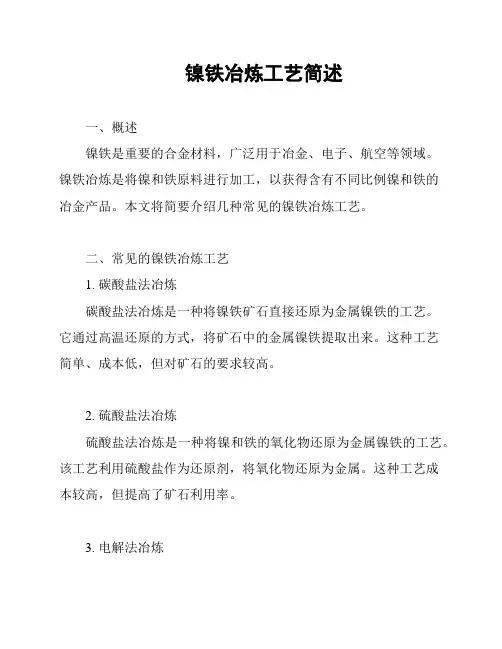
镍铁冶炼工艺简述
一、概述
镍铁是重要的合金材料,广泛用于冶金、电子、航空等领域。
镍铁冶炼是将镍和铁原料进行加工,以获得含有不同比例镍和铁的
冶金产品。
本文将简要介绍几种常见的镍铁冶炼工艺。
二、常见的镍铁冶炼工艺
1. 碳酸盐法冶炼
碳酸盐法冶炼是一种将镍铁矿石直接还原为金属镍铁的工艺。
它通过高温还原的方式,将矿石中的金属镍铁提取出来。
这种工艺
简单、成本低,但对矿石的要求较高。
2. 硫酸盐法冶炼
硫酸盐法冶炼是一种将镍和铁的氧化物还原为金属镍铁的工艺。
该工艺利用硫酸盐作为还原剂,将氧化物还原为金属。
这种工艺成
本较高,但提高了矿石利用率。
3. 电解法冶炼
电解法冶炼是一种利用电解的方法将镍铁分离的工艺。
通过在电解槽中加入适当的溶液,利用电流将镍和铁分离出来。
这种工艺能够得到高纯度的镍和铁,但成本较高。
4. 氟化物法冶炼
氟化物法冶炼是一种利用氟化物溶解镍铁的工艺。
通过在高温下将镍铁与氟化物反应,将金属溶解出来。
这种工艺能够得到高纯度的镍和铁,但操作难度较大。
总结:以上是几种常见的镍铁冶炼工艺,每种工艺都有其特点和适用范围。
在具体应用中,需要综合考虑成本、要求和操作难度等因素,选择合适的工艺进行镍铁冶炼。
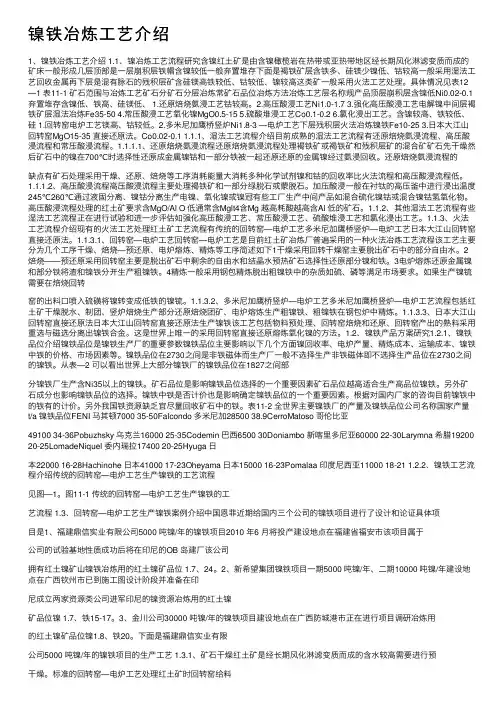
镍铁冶炼⼯艺介绍1、镍铁冶炼⼯艺介绍 1.1、镍冶炼⼯艺流程研究含镍红⼟矿是由含镍橄榄岩在热带或亚热带地区经长期风化淋滤变质⽽成的矿床⼀般形成⼏层顶部是⼀层崩积层铁帽含镍较低⼀般弃置堆存下⾯是褐铁矿层含铁多、硅镁少镍低、钴较⾼⼀般采⽤湿法⼯艺回收⾦属再下层是混有脉⽯的残积层矿含硅镁⾼铁较低、钴较低、镍较⾼这类矿⼀般采⽤⽕法⼯艺处理。
具体情况见表12—1 表11-1 矿⽯范围与冶炼⼯艺矿⽯分矿⽯分层冶炼常矿⽯品位冶炼⽅法冶炼⼯艺层名称规产品顶层崩积层含镍低Ni0.02-0.1弃置堆存含镍低、铁⾼、硅镁低、 1.还原焙烧氨浸⼯艺钴较⾼。
2.⾼压酸浸⼯艺Ni1.0-1.7 3.强化⾼压酸浸⼯艺电解镍中间层褐铁矿层湿法冶炼Fe35-50 4.常压酸浸⼯艺氧化镍MgO0.5-15 5.硫酸堆浸⼯艺Co0.1-0.2 6.氯化浸出⼯艺。
含镍较⾼、铁较低、硅 1.回转窑电炉⼯艺镁⾼、钴较低。
2.多⽶尼加鹰桥竖炉Ni1.8-3 —电炉⼯艺下层残积层⽕法冶炼镍铁Fe10-25 3.⽇本⼤江⼭回转窑MgO15-35 直接还原法。
Co0.02-0.1 1.1.1、湿法⼯艺流程介绍⽬前成熟的湿法⼯艺流程有还原焙烧氨浸流程、⾼压酸浸流程和常压酸浸流程。
1.1.1.1、还原焙烧氨浸流程还原焙烧氨浸流程处理褐铁矿或褐铁矿和残积层矿的混合矿矿⽯先⼲燥然后矿⽯中的镍在700℃时选择性还原成⾦属镍钴和⼀部分铁被⼀起还原还原的⾦属镍经过氨浸回收。
还原焙烧氨浸流程的缺点有矿⽯处理采⽤⼲燥、还原、焙烧等⼯序消耗能量⼤消耗多种化学试剂镍和钴的回收率⽐⽕法流程和⾼压酸浸流程低。
1.1.1.2、⾼压酸浸流程⾼压酸浸流程主要处理褐铁矿和⼀部分绿脱⽯或蒙脱⽯。
加压酸浸⼀般在衬钛的⾼压釜中进⾏浸出温度245℃260℃通过液固分离、镍钴分离⽣产电镍、氧化镍或镍冠有些⼯⼚⽣产中间产品如混合硫化镍钴或混合镍钴氢氧化物。
⾼压酸浸流程处理的红⼟矿要求含MgO/Al O 低通常含Mglt4含Mg 越⾼耗酸越⾼含Al 低的矿⽯。
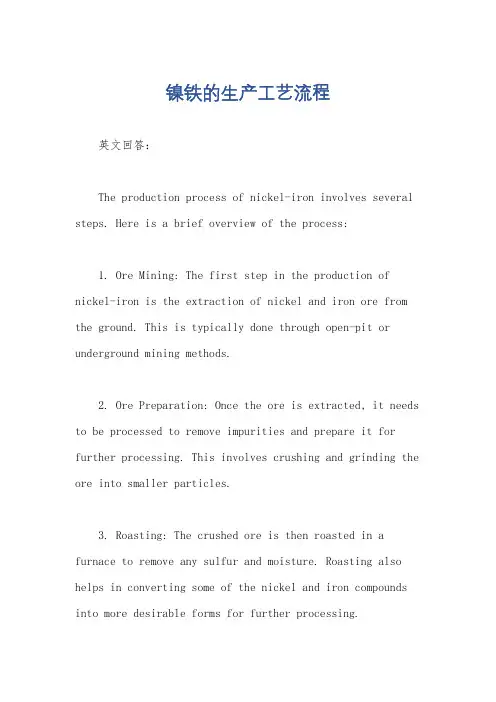
镍铁的生产工艺流程英文回答:The production process of nickel-iron involves several steps. Here is a brief overview of the process:1. Ore Mining: The first step in the production of nickel-iron is the extraction of nickel and iron ore from the ground. This is typically done through open-pit or underground mining methods.2. Ore Preparation: Once the ore is extracted, it needs to be processed to remove impurities and prepare it for further processing. This involves crushing and grinding the ore into smaller particles.3. Roasting: The crushed ore is then roasted in a furnace to remove any sulfur and moisture. Roasting also helps in converting some of the nickel and iron compounds into more desirable forms for further processing.4. Smelting: The roasted ore is then smelted in a furnace at high temperatures to separate the nickel andiron from other impurities. This process involves the use of various chemicals and fluxes to facilitate the separation.5. Refining: The smelted nickel-iron is then further refined to remove any remaining impurities. This is typically done through processes like electrorefining or hydrometallurgical methods.6. Alloying: Once the nickel-iron is refined, it can be alloyed with other metals to enhance its properties. Common alloying elements include chromium, molybdenum, and copper.7. Casting or Forming: The final step in the production process is to cast or form the nickel-iron into the desired shape. This can be done through various methods like casting, extrusion, or forging.Overall, the production process of nickel-iron involvesore mining, ore preparation, roasting, smelting, refining, alloying, and casting/forming.中文回答:镍铁的生产工艺流程包括以下几个步骤:1. 矿石开采,镍铁的生产首先需要从地下提取镍和铁矿石。
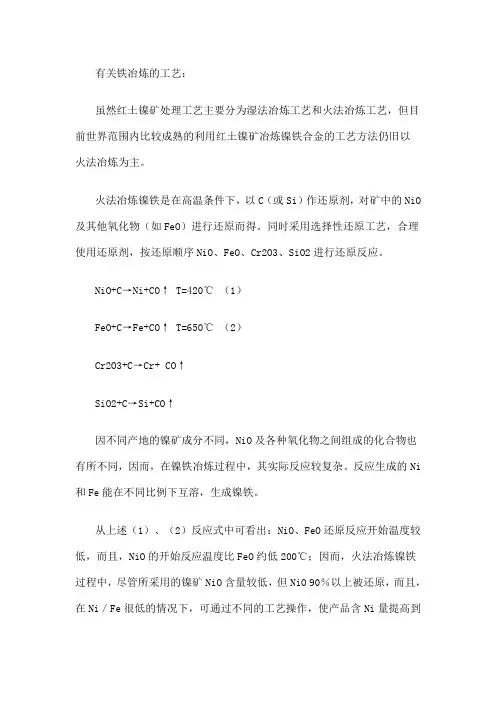
有关铁冶炼的工艺:虽然红土镍矿处理工艺主要分为湿法冶炼工艺和火法冶炼工艺,但目前世界范围内比较成熟的利用红土镍矿冶炼镍铁合金的工艺方法仍旧以火法冶炼为主。
火法冶炼镍铁是在高温条件下,以C(或Si)作还原剂,对矿中的NiO 及其他氧化物(如FeO)进行还原而得。
同时采用选择性还原工艺,合理使用还原剂,按还原顺序NiO、FeO、Cr2O3、SiO2进行还原反应。
NiO+C→Ni+CO↑ T=420℃(1)FeO+C→Fe+CO↑ T=650℃(2)Cr2O3+C→Cr+ CO↑SiO2+C→Si+CO↑因不同产地的镍矿成分不同,NiO及各种氧化物之间组成的化合物也有所不同,因而,在镍铁冶炼过程中,其实际反应较复杂。
反应生成的Ni 和Fe能在不同比例下互溶,生成镍铁。
从上述(1)、(2)反应式中可看出:NiO、FeO还原反应开始温度较低,而且,NiO的开始反应温度比FeO约低200℃;因而,火法冶炼镍铁过程中,尽管所采用的镍矿NiO含量较低,但NiO 90%以上被还原,而且,在Ni/Fe很低的情况下,可通过不同的工艺操作,使产品含Ni量提高到较高水平,与铁合金其他产品(如高碳铬铁、硅合金等)相比,电炉粗镍冶炼难度相对较低。
目前我国镍铁冶炼主要采用高炉法和电炉法两种:1、高炉法:镍矿→脱水、烧结、造块→配入焦炭、熔剂→高炉冶炼→粗镍铁→精炼降Si、C、P、S→镍铁。
在国内,近年采用的火法冶炼镍铁较为普遍,主要是借用于现有炼铁小高炉直接转产,具体操作与小高炉生产生铁操作相似,特别适合于使用低Ni、高Fe镍矿生产低Ni镍铁(含镍生铁)。
该工艺仍以焦炭燃烧放热作为冶炼热能,入炉镍矿中FeO可被焦炭中的C充分还原,故粗镍铁中的Ni含量高低基本受限于入炉镍矿Ni/Fe的比值大小。
由于国家限制400 立方米以下小高炉的使用,而使用矿热电炉,利用低镍高铁镍矿,直接生产低Ni镍铁,其工艺的合理性和易操作性,似乎不及高炉法,因而采用大容量高炉冶炼低Ni镍铁值得关注和研究。
粗制镍铁的生产工艺2008年11月30日星期日 15:27这个工序的生产工艺流程基本上延袭了传统的工艺流程。
进入工厂原料场的氧化镍矿石含有30%以上的水分(结晶水),需要在还原焙烧阶段将水分去除。
这个过程是在一个回转窑中进行的。
矿石在料场破碎、中和混匀以后,向其中加入炭素还原剂和熔剂,充分混合均匀以后加入到回转窑中。
在回转窑中,矿石被焙烧脱水,重量减少30%左右,镍被加入的炭素还原剂还原,形成了温度为600~700℃镍渣。
这些镍渣在隔热的状态下被送入到矿热炉的供料料仓(内衬耐火保温层),根据生产工艺的要求,镍渣通过一个密封的管状布料装置均匀地分配到矿热炉内。
矿热炉在这种工艺流程中是投资最大的设备,为了环保和工业卫生的需要,炉子被密封起来。
在矿热炉中通过电弧冶炼,分离出粗制的镍铁和电炉渣,同时产生含CO75%的还原性气体,这种气体经过净化以后返回到回转窑中作为燃料进行燃烧,提供回转窑所需要的热能,尘灰返到矿热炉继续参与冶炼。
电炉炉渣是一种很好的建筑材料,但是目前仅用于道路的建设。
从矿热炉中得到的镍铁含硫、硅、碳、磷等杂质高,还不适用于冶炼高级不锈钢。
这些粗制的镍铁还需要进行精炼以后才能做为成品出厂。
将1t的原料矿加入回转窑,大约可以得到650~700kg的镍渣,这些镍渣加入到矿热炉中,大约可以得到120~150kg的粗制镍铁。
粗制镍铁中的镍含量一般为14%,最高时可以达到18%根据红土镍矿成分的不同,镍生产厂可以选择不同的冶炼工艺。
中国目前还没有一座大型镍铁生产工厂,为了少走弯路可以引进国外成熟的先进技术,在中国国内制造全部设备,以较少的投资,在最短的时间内,选择适宜的沿海地区建设一座大型镍铁生产厂。
为此,比较详细的介绍了乌克兰帕布什镍厂的火法冶炼镍铁的工艺流程和生产指标。
文章还介绍了在镍铁精炼车间,直接冶炼300系列不锈钢工艺的开发。
1. 开发利用海外镍资源满足中国日益增长的镍需求:尽管中国镍资源的开发与利用近年来得到了快速的发展,但是,发展的速度远远跟不上冶金等行业对镍需求增长的速度。
镍铁生产工艺 [镍铁生产工艺简述]镍铁生产工艺简述(大全)6.1 回转窑一矿热炉工艺(简称RKEF)RKEF工艺生产镍铁是目前开展较快的红土镍矿处理工艺。
其工艺成熟、设备简单易控、生产效率高。
缺乏是需消耗大量冶金焦和电能,能耗大、生产本钱高、熔炼过程渣量过多、熔炼温度(1500℃左右)较高、有粉尘污染等。
而且,矿石含镍品位的上下对火法工艺的生产本钱影响较大,矿石镍品位每降低0.1%,生产本钱大约增加3~4%。
RKEF工艺流程为:矿石配料——回转窑枯燥——回转窑焙烧——炉熔炼粗镍铁——LF炉精炼(或机械搅拌脱硫)——精制镍铁水淬——产出合格镍铁粒。
巴西淡水河谷公司于xx年8月在帕拉(PARA)州开工建设奥卡普马(OncaPuma)镍铁工程,该工程采用RKEF工艺处理红土镍矿生产镍铁,由德玛克公司设计。
工程配置2条Φ4.6×45m枯燥窑、2条Φ6×135 m回转窑、2台120000 kVA矩型矿热炉(目前世界最大功率),年产合金22万吨(品位25%),镍5.2万吨。
国内RKEF工艺处理红土镍矿近几年也向大型化开展。
青山集团投资建设的福安鼎信镍铁公司,由中国恩菲工程技术设计,工程采用2条Φ5×40 m枯燥窑、4条Φ4.8×100 m回转窑、4台33000 KVA 圆型矿热炉,年产镍2万吨。
两条线于xx年6月投产,到目前为止,生产稳定、指标良好,本钱国内最低,是国内最早采用大型矩形矿热电炉生产镍铁的RKEF工艺的典范。
该公司又在广东阳江建设2台60000 kVA圆形矿热电炉,已投产。
该工艺适合处理镁质硅酸盐型红土矿A型、中间型红土矿C1、C2型。
且Ni品位>1.6%,最好1.8%,这样有利于节约生产本钱。
6.2 回转窑一磁选回转窑——磁选工艺又名直接复原工艺,目前世界上采用此工艺的只有日本冶金公司大江山冶炼厂。
主要工艺过程为原矿磨细与粉煤混合制团,团矿在回转窑中经枯燥和高温复原焙烧,焙烧矿再磨细,矿浆进行重选和磁选别离得到镍铁合金产品。
镍铁冶炼工艺1.1 高镍合金工艺选择含镍红土矿是由含镍橄榄岩在热带或亚热带地区经长期风化淋滤变质而成的。
由于风化淋滤,矿床一般形成几层,顶部是一层崩积层(铁帽),含镍较低;中间层是褐铁矿层,含铁多、硅镁少,镍低、钴较高,一般采用湿法工艺回收金属;底层是混有脉石的腐植土层(包括硅镁性镍矿),含硅镁高、低铁、镍较高、钴较低,一般采用火法工艺处理。
(1)湿法工艺流程较成熟的湿法工艺流程有:Caron 流程和 HPAL 流程(HighPressure Acid Leach)。
Caron流程处理褐铁矿或褐铁矿和腐植土的混合矿,矿石先干燥,再还原,矿石中的镍在700℃时选择性还原成金属镍(钴和一部分铁被一起还原),还原的金属镍经过氨浸回收。
干燥、焙烧、还原等火法工艺,消耗能量大;回收金属采用湿法工艺,消耗多种化学试剂;镍和钴的回收率比火法流程和 HPAL 流程低。
HPAL流程主要处理褐铁矿和一部分绿脱石或蒙脱石。
加压酸浸一般在衬钛的高压釜中进行,浸出温度170℃~245℃,通过液固分离、镍钴分离,生产电镍、氧化镍或镍冠,有些工厂生产中间产品如硫化物或氢氧化物。
HPAL 流程处理的红土矿要求含Al低、含Mg低,通常含Mg<4%,含Mg越高,耗酸越高。
(2)火法工艺流程红土矿储镍量约占镍总储量的70%,到2003年,红土矿产镍量占镍总产量的42%。
红土矿产镍量的70%是采用火法工艺流程回收的。
火法工艺处理红土矿的工艺流程有传统的 RKEF 流程(回转窑—矿热炉工艺)、多米尼加鹰桥竖炉—矿热炉法、日本大江山回转窑直接还原法等。
多米尼加鹰桥竖炉—矿热炉工艺流程包括将红土矿干燥脱水、制团、竖炉焙烧部分还原焙烧团矿、矿热炉熔炼生产粗镍铁、粗镍铁在钢包炉中精炼等工序。
日本大江山回转窑直接还原法生产镍铁,是唯一采用回转窑直接还原熔炼氧化镍的火法工艺。
该流程分为三个步骤:(1)物料预处理:磨矿、混合与制团,以提高回转窑操作效果;(2)冶炼工艺:回转窑焙烧、金属氧化物还原与还原金属的聚集;(3)分离处理:回转窑产出的熟料采用重选与磁选分离出镍铁合金。